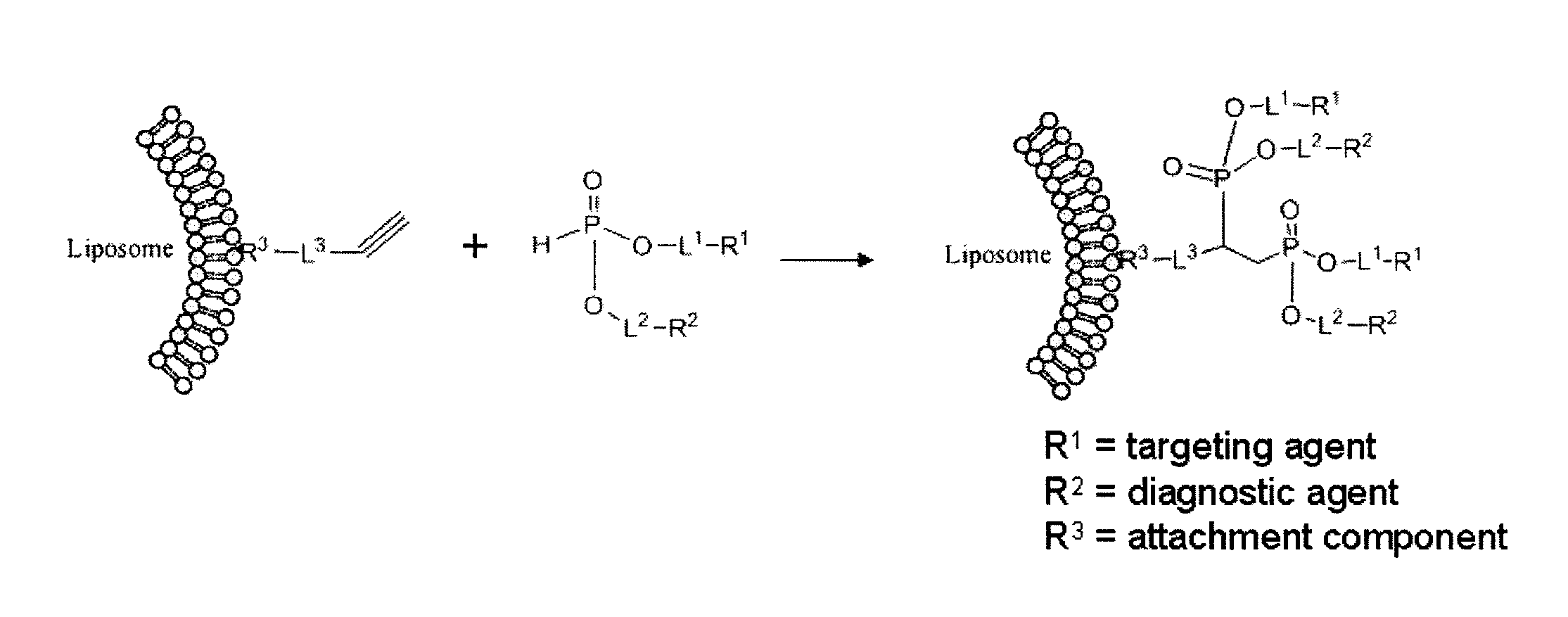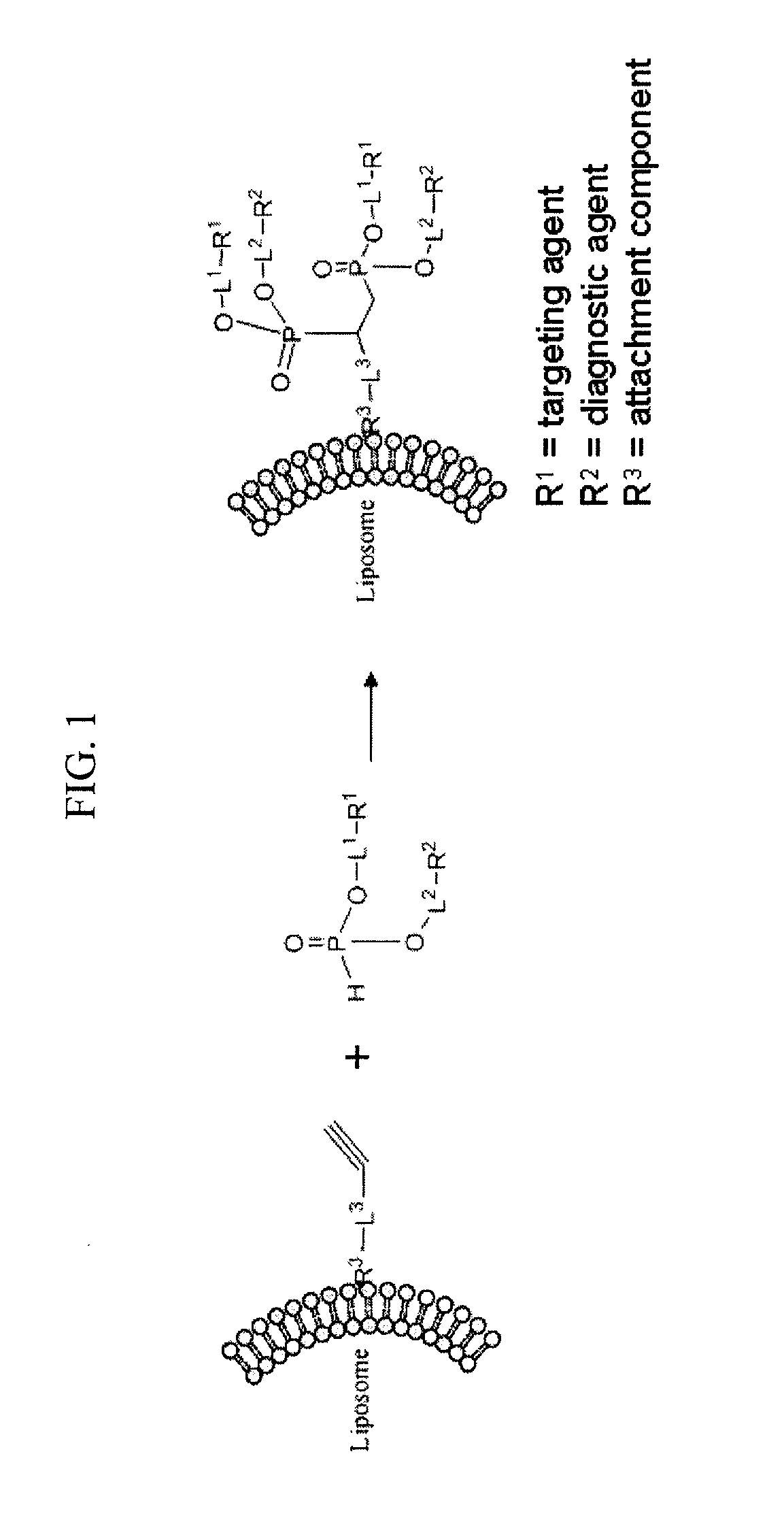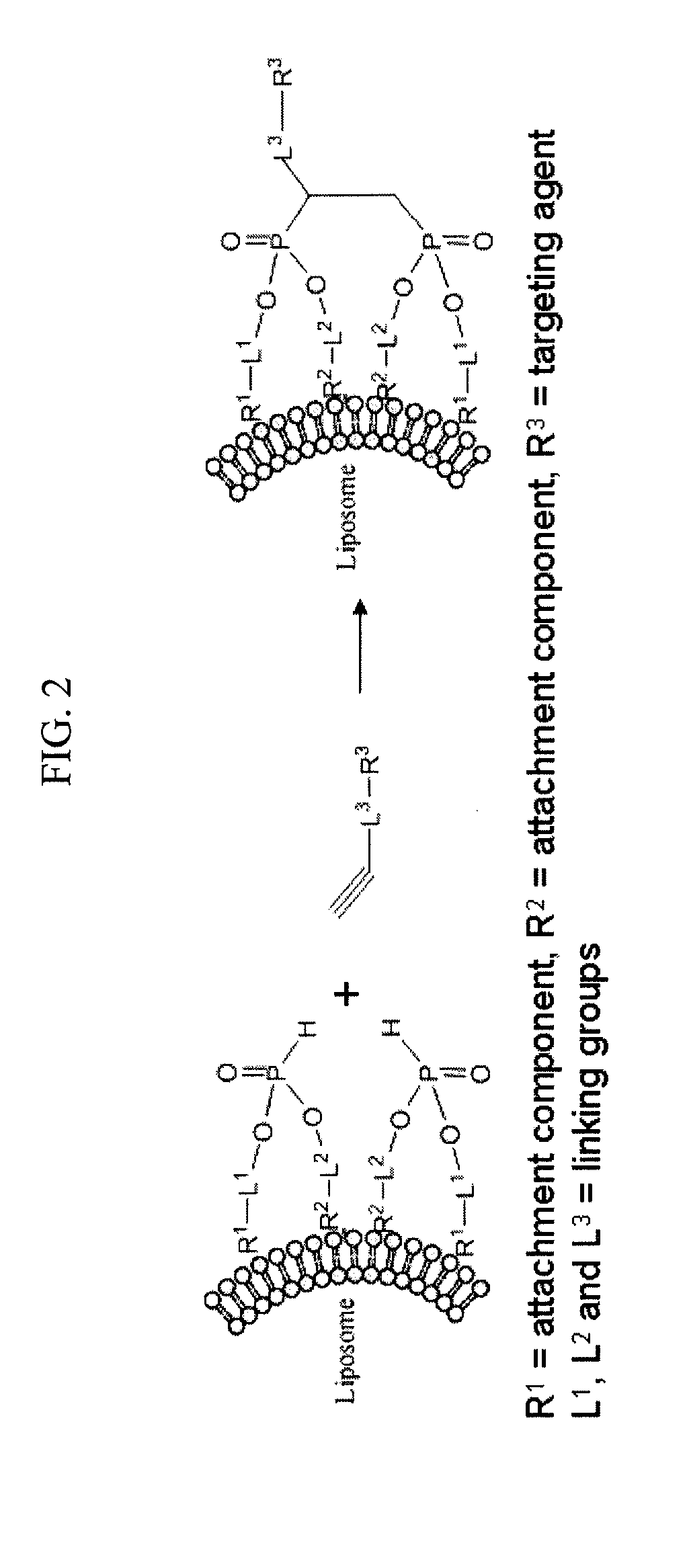Remote Assembly of Targeted Nanoparticles using H-Phosphate ENE/-YNE Hydrophosphonylation Reactions
- Summary
- Abstract
- Description
- Claims
- Application Information
AI Technical Summary
Benefits of technology
Problems solved by technology
Method used
Image
Examples
example 1
Preparation of dioctadecyl oct-1-en-2-ylphosphonate
[0122]FIG. 3 shows the general reaction scheme for preparing dioctadecyl oct-1-en-2-ylphosphonate. Tetrakis(triphenylphosphine)palladium(0) (0.10 g, 0.09 mmol), dioctadecyl phosphonate (1.56 g, 2.66 mmol), THF (6 mL) and 1-octyne (0.30 g, 2.69 mmol) in a crimped top microwave vial with stir bar was subjected to microwave radiation (Biotage Initiator) @110° C. for 90 min. The light brown reaction mixture was checked by 31P NMR (CDCl3) and the reaction determined to be complete. It was evaporated and the crude product was purified by normal phase flash chromatography (40 g silica column) with hexanes-ethyl acetate gradient (0% to 10% ethyl acetate over 15 min, 48 mL / min flow rate, ELSD detection) to yield product, dioctadecyl oct-1-en-2-ylphosphonate (1.61 g, 86.7%, 90% exo-isomer, A, and 10% E-isomer, B). 1H, 13C and 31P NMR spectra of exo-isomer, A, showed peaks consistent with the desired structure. An extracted ion liquid chromato...
example 2
Preparation of 5-(bis(octadecyloxy)phosphoryl)hex-5-enoic acid
[0123]FIG. 4 shows the general reaction scheme for preparing 5-(bis(octadecyloxy)phosphoryl)hex-5-enoic acid. Tetrakis(triphenylphosphine)palladium(0) (0.11 g, 0.09 mmol), dioctadecyl hydrogen phosphonate (1.55 g, 2.64 mmol), THF (6 mL) and 5-hexynoic acid (0.30 g, 2.69 mmol) in a crimped top microwave vial with stir bar was subjected to microwave radiation (Biotage Initiator) @110° C. for 90 min. The yellow reaction mixture was checked by 31P NMR (CDCl3) and the reaction determined to be complete. It was evaporated and the crude product was purified by normal phase flash chromatography (40 g silica column) with hexanes-ethyl acetate gradient (0% to 100% ethyl acetate over 10 min, 48 mL / min flow rate, ELSD detection) to yield product, 5-(bis(octadecyloxy)phosphoryl)hex-5-enoic acid (0.98 g, 52.8%, 96% exo-isomer, C and 4% E-isomer, D). 1H, 13C and 31P NMR spectra of exo-isomer, C, showed peaks consistent with the desired ...
example 3
Coupling of 5-(bis(octadecyloxy)phosphoryl)hex-5-enoic acid with PEG1000-NH2 (m-dPEG®24-amine)
[0124]FIG. 5 shows the general reaction scheme for coupling of 5-(bis(octadecyloxy)phosphoryl)hex-5-enoic acid with PEG1000-NH2. m-dPEG®24-amine (102.0 mg, 0.09 mmol), 5-(bis(octadecyloxy)phosphoryl)hex-5-enoic acid (64.4 mg, 0.09 mmol), triethylamine (13.3 mg, 0.13 mmol), DMF (2 mL) and CHCl3 (1 mL) in a 25 mL RBF were stirred under argon atmosphere at room temperature for 30 minutes. TBTU (35.7 mg, 0.11 mmol) was added to the reaction mixture solution and stirring continued at room temperature for 16 h. Volatiles were removed by rotary evaporation and the crude product was purified by normal phase flash chromatography (4 g silica column) with chloroform-methanol gradient (0% to 10% methanol over 10 min, 10 mL / min flow rate, ELSD detection) to yield product, dioctadecyl (75-oxo-2,5,8,11,14,17,20,23,26,-29,32,35,38,41,44,47,50,53,56,59,62,65,68,71-tetracosaoxa-74-azaoctacont-79-en-79-yl)pho...
PUM
 Login to View More
Login to View More Abstract
Description
Claims
Application Information
 Login to View More
Login to View More - R&D
- Intellectual Property
- Life Sciences
- Materials
- Tech Scout
- Unparalleled Data Quality
- Higher Quality Content
- 60% Fewer Hallucinations
Browse by: Latest US Patents, China's latest patents, Technical Efficacy Thesaurus, Application Domain, Technology Topic, Popular Technical Reports.
© 2025 PatSnap. All rights reserved.Legal|Privacy policy|Modern Slavery Act Transparency Statement|Sitemap|About US| Contact US: help@patsnap.com



